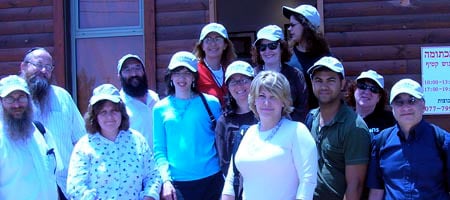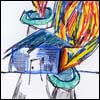Victims of Hurricane Katrina met with Gaza Strip evacuees this week to discuss their shared experiences in having their lives uprooted by forces beyond their control.
On August 29, 2005 – just days after the Israeli government forcibly removed Jewish residents from the community of Neve Dekalim and the rest of the Gush Katif bloc of settlements – Katrina slammed into New Orleans, sending the waters of Lake Pontchartrain coursing through its streets and submerging much of the southern city. More than 1,900 died in New Orleans due to the storm and its effects; today, the Big Easy is still reeling from crippling unemployment and crime.
On Sunday a dozen members of the Chabad Center of Metairie – Katrina's storm surge flooded the suburban New Orleans synagogue and community center to a depth of two feet – met with Neve Dekalim evacuees in their new home of Nitzan, a town in the sand dunes outside of Ashkelon comprised almost entirely of former Gaza Strip residents.
The group was in the country for a weeklong tour that ended Wednesday. The meeting was arranged by Rabbi Shalom Stark of the Jerusalem-based VIP Tours.
During Israel's unilateral disengagement and handover of the Gaza Strip to the Palestinian Authority, residents of Neve Dekalim packed up their synagogue's ark, Torah scrolls and other items, and headed off to a new life of temporary shelters. In Nitzan's synagogue, resident Debbie Rosen addressed the New Orleans crowd, pointing out that the synagogue's ark was from the shul in Neve Dekalim, which has since been destroyed.
As they listened to Rosen's story of torn families, shattered communities and living in caravans, members of the New Orleans group nodded their heads almost in unison and voiced an understanding of the Israeli town's predicament.
"It was the same in New Orleans," said Chanie Nemes, co-director of the Metairie, La., Chabad House.
For two weeks, New Orleans was off limits to anyone but rescue personnel, and in that time mold finished off what the flood waters didn't destroy of the Chabad synagogue's walls and flooring. The structure's entire interior, in fact, had to be torn out and rebuilt. With 80 to 90 percent of its furniture and other items from before Katrina destroyed, the Chabad House plans to be fully operational by Yom Kippur.
Rosen attempted to distinguish between the two groups' predicaments. After all, she said, Neve Dekalim fell victim to Israeli government policies. New Orleans, however, was left in ruins by the forces of nature.
That argument, however, didn't sit well with the Louisiana contingent, some of whom are part of a class-action law suit against the U.S. Army's Corps of Engineers. They pointed out that had the federal government heeded engineers' warnings dating back to 1992 that the New Orleans levee system was inadequate, hundreds of lives and millions of dollars in property could have been saved.
$100,000 Mobile Homes
Both groups agreed that what their governments have done since to help rebuild have been a series of half-measures; corruption riddles each system, they said.
Rachel Saperstein, a former English teacher and Neve Dekalim settler, showed the out-of-town visitors the cement marks left by contractors in her caravilla, a series of four caravans joined together and topped by a red-tile roof. Her house cost the Israeli government $100,000, she said, but a real estate agent estimated its value at $17,000.
Several of the New Orleans residents immediately interjected that their caravans, about a quarter of the size of the Nitzan caravillas, cost the U.S. government somewhere between $70,000 and $100,000
United in their skepticism and downright suspicion of their respective governments' policies, the Israeli and American evacuees turned their discussion to what efforts are currently under way to benefit the former Gaza residents.
When Rosen finished her presentation, a yeshiva student briefed the crowd on a Chabad Youth Organization initiative to create a mobile library for children from Gush Katif who are finding it difficult integrating into new schools.
Following a tour of the truck that will become the mobile library, Rosen showed the New Orleans visitors Nitzan's newly-opened pizza shop, at which point the guests told of their communal joy at the reopening of Casablanca, a kosher restaurant in New Orleans.
For his part, Rabbi Yossie Nemes, who with his wife Chanie organized the Israel trip, told of the need look beyond one's own depression and worries following disasters. It's important to stay strong, he said, and appreciate what one still has.
When the storm struck New Orleans, he related, two of his daughters were reciting Psalms underneath their house's sun window. In the howling wind, a tree from the back yard fell right onto the window, and yet the glass didn't break. They all sensed G‑d's protection that day, he said.
Rosen acknowledged that it was important to bond with others who have lived through similar events.
"If anyone understands us, it's you," she told the American visitors.








Join the Discussion